

16' High
| Click here for the introduction on high crosses and other images of high crosses. Click here to see details of the east side of the Muiredach Cross. Click here to see details of the north and south side. The cemetery of the Monastery of Monasterboice and the west side of the Muiredach cross | |
 |
The Monastery of Monasterboice, founded by St. Buithe mac Bronach (died 521) in the late 5th century, was a prosperous center of learning in later centuries (10th and 11th). Its round tower, with books and treasures, was burned in the early 12th century and by 1122 the monastery community probably ended, even though Monasterboice continued to be a secular parish.Perhaps as many as six high crosses existed at this site. The so-called Muiredach Cross (south cross) and west cross still stand, almost undamaged, and a third cross, the north cross, survives in part. |
The west side with the central crucifixion scene | |
 |
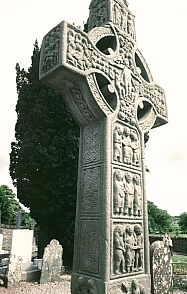 |
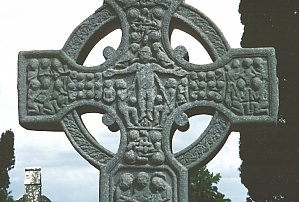 |
The CrucifixionA young beardless Christ occupies the center. As is typical in medieval and Irish depictions, He is the Christus Triumphans type--alive and without suffering. Above his arms are two angels. Above and below the scene are spiral bosses and intertwined animals. Two soldiers stand symmetrically on each side of Christ, one the spearbearer who pierces His left side while the other holds a cane with a cup, perhaps a substitute for the spongebearer. Between the soldiers and Christ's knees are two heads, perhaps indicating the two thieves. |
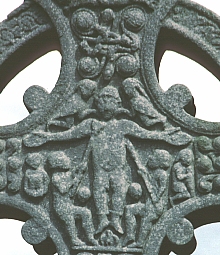 |
Detail of the CrucifixionThe bird under Christ's feet may represent the phoenix, a common symbol for the resurrection. Between the spiral bosses and the two soldiers are two small figures, the one on the left (Christ's right--his "good" side) seated frontally, the one on the right (Christ's left and "bad" side) with its back turned. These probably are personifications of the sun and moon, regular features of medieval crucifixions. Adopted from pagan imagery, they came to prefigure the relationship of the New and Old Testaments since the Old Testament (the moon) was only to be understood by the light of the New (the sun). |
The right cross arm with the ResurrectionThe right cross arm depicts the Resurrection with guards kneeling on each side of the tomb and three angels behind them holding in a napkin a small figure representing the soul. |
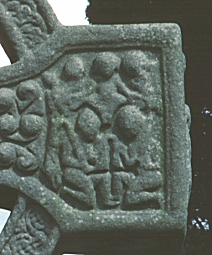 |
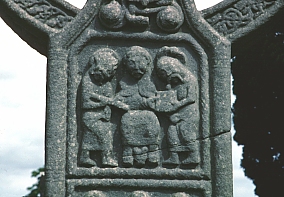 |
Christ as Ruler of the WorldChrist is enthroned between St. Peter and St. Paul. He gives the keys to Peter on His right and a book to Paul. |
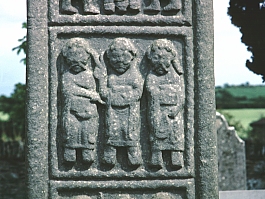 |
Doubting ThomasIn the center Christ holds up His right hand as if saying to Thomas on his right, "Reach your finger here; see my hands. Reach your hand here and put it into my side. Be unbelieving no longer, but believe" (John 20:27). The figure on the right with the book may be St. John the Evangelist, who alone tells this post-resurrection story. |
 |
The Arrest of Christ (or the Ecce Homo)A young beardless Christ stands in the center held by two soldiers; thus, this could be a depiction of the arrest of Christ. Because Christ is dressed in regal fashion with a large, ornate brooch and because he carries a wand (sceptre), this may represent the mocking of Christ when the soldiers dressed Him in a purple robe and crown of thorns and gave him a mock sceptre of reed, hailing Him as "King of the Jews." (John 19:4-6) |
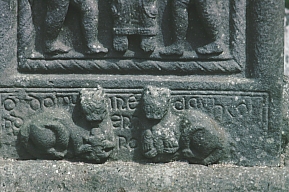 |
The lowest part of the shaftTwo felines, one with a kitten, the other with a bird, sit in high relief before an inscription which is usually translated "a prayer for Muiredach for whom the cross was made [or who caused the cross to be erected]." The Muiredach in this inscription is generally thought to be the abbot who died in 922/23, thus giving the cross its name and the suggested dating (900-923). |
Click here to see details of the east side of the Muiredach Cross.
![]() Click here to return to places index.
Click here to return to places index.
![]() Click here to return to index of artists and architects.
Click here to return to index of artists and architects.
![]() Click here to return to chronological index.
Click here to return to chronological index.
![]()